For centuries, turmeric has been revered in Ayurvedic and traditional medicine for its potent skincare properties. Modern research confirms that curcumin, turmeric's active compound, delivers significant antioxidant and anti-inflammatory benefits when applied topically. This comprehensive guide explores the science-backed advantages of turmeric face masks, proper formulation techniques to maximize benefits while minimizing staining, and evidence-based application protocols for different skin concerns.
The Science Behind Turmeric for Skincare
Multiple clinical studies validate turmeric's effectiveness in skincare formulations. Research published in Phytotherapy Research demonstrates that curcumin inhibits inflammatory pathways in skin cells, making it particularly beneficial for inflammatory skin conditions. A 2016 study in Journal of Clinical and Aesthetic Dermatology found that topical turmeric applications reduced acne lesions by 2.5 times compared to placebo after four weeks of consistent use. The compound's antioxidant properties also combat free radical damage that contributes to premature aging.

Proven Benefits of Turmeric Face Masks
Unlike many natural skincare trends, turmeric's benefits are supported by clinical evidence. When properly formulated, turmeric face masks deliver:
- Acne reduction through antimicrobial and anti-inflammatory action
- Hyperpigmentation improvement by inhibiting melanin production
- Redness reduction for sensitive or rosacea-prone skin
- Antioxidant protection against environmental damage
- Gentle exfoliation when combined with natural exfoliants
Understanding Potential Side Effects
While generally safe, turmeric face masks require proper handling. The most common issue is temporary yellow-orange staining, particularly on lighter skin tones. This staining typically washes off with proper cleansing but may linger for 24-48 hours. More concerning are potential allergic reactions - approximately 2% of users experience contact dermatitis. Always perform a patch test 24 hours before full application, especially if you have sensitive skin or known allergies to plants in the ginger family.
How to Make Turmeric Face Mask at Home: Three Evidence-Based Formulas
Creating an effective turmeric face mask requires balancing potency with skin compatibility. These recipes incorporate ingredients that enhance turmeric's absorption while minimizing staining:
| Skin Concern | Recipe | Application Frequency | Key Benefits |
|---|---|---|---|
| Acne-prone skin | 1 tsp turmeric, 1 tbsp raw honey, 1 tsp aloe vera gel | 2-3 times weekly | Antibacterial, reduces inflammation, soothes irritation |
| Dull complexion | 1 tsp turmeric, 1 tbsp plain yogurt, 1 tsp lemon juice | 1-2 times weekly | Brightens, gently exfoliates, improves texture |
| Redness and sensitivity | 1/2 tsp turmeric, 1 tbsp oat flour, 1 tbsp cooled chamomile tea | 1-2 times weekly | Calms inflammation, soothes irritation, strengthens barrier |
Step-by-Step Application Guide
Proper application technique maximizes benefits while minimizing potential issues:
- Prep your skin: Cleanse thoroughly and perform patch test if new to turmeric
- Mix carefully: Combine dry turmeric with wet ingredients first to prevent clumping
- Apply evenly: Use fingers or brush, avoiding eye area
- Set timer: Leave on for 10-15 minutes (never exceed 20 minutes)
- Remove properly: Rinse with lukewarm water using circular motions
- Follow with moisturizer: Apply gentle moisturizer to seal benefits
How Often to Use Turmeric Face Mask
Frequency depends on your skin type and concerns. For most users, 1-2 applications weekly provides optimal results without irritation. Those with acne-prone skin may benefit from 2-3 weekly applications initially, then reducing to maintenance frequency once improvement occurs. Always monitor your skin's response and reduce frequency if you notice dryness or irritation. Consistent use over 4-6 weeks typically yields visible improvements in skin clarity and tone.
Turmeric Face Mask for Glowing Skin: Professional Tips
Skincare professionals recommend these evidence-based techniques to enhance results:
- Add a pinch of black pepper to increase curcumin absorption by up to 2000%
- Use organic turmeric powder for maximum potency and purity
- Apply mask in the evening to allow staining to fade overnight
- Follow with vitamin C serum to boost brightening effects
- Store unused mixture in airtight container for up to 3 days
Frequently Asked Questions
Does turmeric face mask really lighten skin?
Turmeric doesn't bleach skin but can improve hyperpigmentation and create a more even complexion by inhibiting melanin production. Clinical studies show it reduces dark spots and post-inflammatory hyperpigmentation with consistent use over 4-8 weeks. It works by addressing the underlying inflammation that contributes to uneven skin tone rather than bleaching the skin.
How to remove turmeric stains from skin effectively?
To remove turmeric stains, wash with a gentle cleanser and warm water immediately after removing the mask. For stubborn stains, create a paste of baking soda and water and gently massage onto stained areas. Follow with a moisturizer as baking soda can be drying. Most stains fade completely within 24 hours. Applying coconut oil before the mask can create a barrier that minimizes staining.
Can I leave turmeric face mask overnight?
No, leaving turmeric face mask overnight isn't recommended. Extended contact increases staining risk and may cause irritation or dryness. The optimal application time is 10-15 minutes. Turmeric's active compounds are absorbed effectively within this timeframe, and longer exposure doesn't enhance benefits but does increase potential side effects. For best results, follow the recommended timing in evidence-based recipes.
Is turmeric face mask suitable for all skin types?
Turmeric face masks benefit most skin types but require formulation adjustments. Those with sensitive skin should use lower concentrations (1/2 tsp turmeric) and combine with soothing ingredients like oat flour or aloe vera. Oily and acne-prone skin benefits from combinations with honey or yogurt. Dry skin types should incorporate hydrating ingredients like avocado or olive oil. Always perform a patch test first, as approximately 2% of people experience allergic reactions to turmeric.











 浙公网安备
33010002000092号
浙公网安备
33010002000092号 浙B2-20120091-4
浙B2-20120091-4